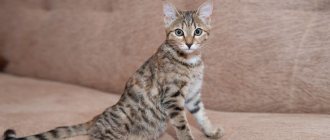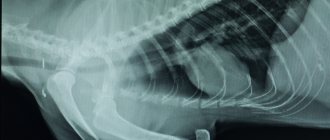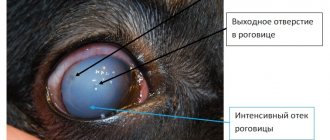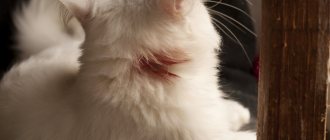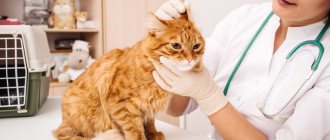Flatulence or increased gas production is a problem familiar not only to humans, but also to animals.
Under normal conditions, slight gas formation occurs 3-4 hours after eating.
If the process of gas formation is associated with severe distension or bloating, and is also accompanied by the release of gases of a repulsive odor mixed with hydrogen sulfide, then this indicates the beginning of a pathological process.
The main cause of flatulence in cats is considered to be a violation of enzymatic activity as a result of the consumption of unusual food.
But if increased gas formation becomes chronic, you need to contact a veterinarian for help.
Severe bloating negatively affects the diaphragm, making breathing difficult. In some cases, the cat may develop shock, causing death.
General information
Flatulence is distension of the stomach or intestines from gases or atmospheric air swallowed when eating or drinking. The term flatulence is also used to refer to the passage of intestinal gases through the anus. Even a healthy cat releases at least a liter of gases into the environment every day, but a sick animal can turn into a real “gas generator.” By the way, more than 90% of the total volume released is ordinary methane, which has no odor. Foul-smelling discharge is a consequence of the admixture of hydrogen sulfide and other “fragrant” substances. And it’s good when the resulting excess can come out - it’s much worse when it accumulates in the intestinal cavity, since this can even lead (in especially severe cases, of course) to its rupture.
Thus, the production and excretion of intestinal gases is a completely normal, physiological phenomenon characteristic of any mammal. Even their excessive production does not always indicate some kind of disease. In particular, flatulence can be benign and short-lived, arising as a result of eating a lot of food or eating some unusual food, to which the cat’s body simply has not had time to get used to and has not yet developed the set of enzymes necessary for its digestion (a characteristic symptom in this case is diarrhea). Flatulence can also be recurrent, chronic, and/or “diagnostic.” In the latter case, it indicates some kind of disease of the gastrointestinal tract. It is for this reason that chronic bloating should not be ignored - some kind of trouble has probably happened to your pet’s intestines.
Main predisposing factors
Aerophagia (“eating” air) is a phenomenon observed during greedy, hasty eating of food. In this case, the animal swallows large volumes of atmospheric air, which accumulates in its digestive system. Diets that contain inappropriately large amounts of soy and other legumes also contribute to bloating. It must be remembered that cats, unlike dogs, are much more sensitive to low-quality products - feeding spoiled food will lead to food poisoning and serious bloating.
The same area includes food allergies and food intolerances. If a cat’s body exhibits inadequate reactions to some of the components of the food, the likelihood of flatulence is very high. In particular, you need to remember that cats are primarily carnivores, and therefore should be fed accordingly. Many cats have congenital intolerance to fiber, and therefore feeding their pets only cereals and bread is unacceptable. Firstly, the animal’s body will not be able to obtain the required amount of nutrients from such food. Secondly, fiber is an ideal fermentation substrate, and therefore the cat will always become bloated if there is a high content of it in food. We list other possible reasons:
- Any infectious disease. When, for example, a pathogenic strain of Escherichia coli “takes root” in the intestines, this has a serious impact on the entire normal microflora of the gastrointestinal tract. Toxins released by pathogens of infectious diseases are as harmful to them as to the entire body.
- Inflammatory bowel disease is also a very likely cause of severe flatulence. Vomiting, diarrhea, flatulence, poor appetite and weight loss are common clinical signs of inflammatory gastrointestinal pathologies.
- This happens when hair stones accumulate in the stomach. This is especially true for representatives of long-haired breeds.
- Oncological diseases such as lymphosarcoma can also cause flatulence.
- Viral and parasitic intestinal diseases are often accompanied by swelling of the digestive organs. In young animals and kittens, in particular, chronic intestinal bloating is a common consequence of parascariasis.
- Flatulence is not uncommon due to intestinal obstruction or partial patency. Gases simply have nowhere to go, which is why they accumulate in the lumen of the digestive organs. In the most severe cases, the pressure of the accumulated gases is such that they push feces ... into the stomach and esophagus. Vomiting, in which feces are released, is one of the most characteristic signs of intestinal obstruction. If it is not eliminated as soon as possible, the animal will inevitably die either from severe intoxication or from severe internal bleeding caused by an “explosion” of the intestines.
Owners often treat their pets by pouring liters of antibiotics into them. If they have at least some idea about veterinary medicine, and manage not to poison their pet with human drugs that are toxic to it, everything ends well... Except for the complete “genocide” of beneficial microflora. As a result, the process of normal digestion is disrupted, which leads to constant bloating.
Clinical picture
Of course, when a cat constantly passes gas, the diagnosis is quite simple. But it’s still worth remembering that there are other clinical signs that directly indicate flatulence:
- Vomit.
- Diarrhea or constipation.
- Rumbling in the stomach, also known as borborygmy. Occurs when intestinal gas bubbles begin to “roll” in the intestines.
- Copious release of gases through the anus. Sometimes the smell is so strong that it is impossible to be in the same room with the animal.
- Muscle spasms causing severe pain. It is impossible to touch the stomach of a sick cat, since the animal reacts to such attempts very inadequately and aggressively.
In addition, the stomach of a sick pet noticeably swells and feels like a drum. The muscles become very tense. The cat cannot lie or sit quietly, constantly fidgets, and sometimes howls in pain. A pet in this state refuses food, and thirst may persist.
Description of the problem
Flatulence is not a disease, but a manifestation of a whole complex of disorders in the cat’s body. These animals suffer from increased gas production less often than other domesticated four-legged predators - dogs. This is explained by the anatomy of the animal - a relatively short straight intestine, due to which poorly digested remains of the food bolus are quickly expelled from the cat's body.
Apart from excess gases, the animal may not be bothered by anything, but there may be accompanying ailments:
- hiccups;
- belching;
- nausea;
- diarrhea or constipation, stool with mucus or blood;
- vomiting, including with mucus or blood;
- pain along the intestines;
- increasing the pet's abdominal circumference.
The animal takes a defecation position, meows, but there are no bowel movements. Or, instead of feces, the cat “releases gases.”
Diagnostics and therapy
A complete medical examination of the animal is very important, helping to determine the root cause of flatulence and associated primary diseases. The following methods are used in veterinary medicine:
- Complete and biochemical blood test, urine test.
- Stool analysis is very important, since using this method you can easily detect intestinal parasites and suggest the presence of tumors in the intestines.
- In complex and doubtful cases, they resort to radiography and ultrasound examination of the abdominal cavity.
So, what to do and how to rid your cat of flatulence? Firstly, you need to immediately review your pet’s diet. All “doubtful” components that, at least hypothetically, can cause digestive disorders in animals should be excluded from it.
It is necessary to prevent greedy, abundant absorption of food. To do this, the daily food intake must be divided into small portions. It is very important that a feeding cat eats in “splendid isolation”; it does not need to be disturbed. In addition, it is important to accustom your pet to the fact that feeding occurs at the same time. A strict regime is the key to healthy digestive organs. Don't let your cat eat spoiled food! Do not feed him stale food from the refrigerator; the illusory savings are not worth the spoiled health of your pet. If your cat likes to dig through the trash, be sure to have a “cunning” bucket that does not allow the animal to get to its contents. Food for cats that are prone to constant bloating should not contain a large amount of dietary fiber and fiber - all of which contribute to the development of flatulence.
Movement is life! It is known that pets suffering from physical inactivity have a much higher risk of developing diseases of the gastrointestinal tract and, accordingly, flatulence. If you have the opportunity, let your cat go for a walk, or at least take him for walks regularly. This can be done even in large cities, fortunately it is easy to purchase a harness for walking. When such opportunities are not available, organize “sports activities” for your pet at home. Get a claw sharpener and buy more toys for your cat. This will make him run and play, reaching his daily “norm”.
All this will require fairly modest costs, which any pet owner can handle. I would like to note that it is better not to touch the cat immediately after eating, as he needs to rest. Otherwise, it is possible not only to disrupt the normal digestion process, but even torsion, which may well result in death. Although this pathology is not very typical for cats, one should not forget about its possibility.
Regardless of the root cause of flatulence - poor nutrition, or inflammatory bowel disease, flatulence in cats is a rather dangerous pathology. Treatment should begin immediately, without delay. After all, bloating can contribute to intestinal volvulus or even rupture of the digestive organs, which is extremely dangerous. It can also indicate helminthic pathologies, potentially dangerous not only for the animal itself, but also for its owners.
In addition, the constant emission of foul-smelling gases by animals is a serious “social” problem. So don't wait, take your pet to the vet right away.
Diagnostic measures
Is it possible to identify ascites at home based on external signs? No. It is impossible to be guided only by the described symptoms of abdominal dropsy to make a diagnosis.
At the first signs, it is necessary to take the cat to the veterinary clinic as soon as possible. Only a doctor can identify the cause of the condition, stage and severity of the process based on a visual examination, collected medical history and research results.
Diagnostic measures based on which a veterinarian can identify ascites and determine its etiology:
- palpation;
- laboratory tests of blood and urine to determine biochemical parameters;
- Ultrasound of the abdominal space;
- X-ray;
- CT scan;
- puncture of the abdominal cavity for laboratory examination of transudate.
Symptoms of a bloated belly in a kitten
With an enlarged abdomen, the kitten develops negative symptoms, which are expressed in profuse vomiting, diarrhea and general intoxication syndrome.
Vomit
An enlarged abdomen is almost always accompanied by profuse vomiting. It appears both after eating and after drinking. The kitten has a decreased appetite, an exhausted appearance, and dehydration.
A domestic kitten has a swollen belly
Diarrhea
If the abdomen becomes distended, cats may experience diarrhea, which is expressed in a change in the condition of the stool, the appearance of blood streaks and particles of undigested food in it. Against the background of an unpleasant symptom, appetite worsens and drowsiness appears.
And others
Additional symptoms of abdominal enlargement in cats include:
- weakness, constant drowsiness;
- refusing food or eating it in limited quantities;
- restless and anxious behavior at night, insomnia;
- meowing when going to the toilet;
- constant change in stool;
- vomiting and cough;
- decrease and increase in nasal temperature: it becomes either hot or cold;
- weight loss.
The owner may also notice a change in the quality of the fur of their beloved pet. Constipation is one of the main symptoms that leads to general intoxication of the body.
Important! In advanced cases, the situation requires surgical intervention.
Turn of the century
Entropion, or entropion, is a pathological condition accompanied by the turning of the upper or lower eyelid inward, towards the eyeball. This phenomenon may be due to hereditary, acquired or age-related factors.
At the beginning of the development of the pathological process, the pet begins to blink frequently due to the drying out of the eye. He develops photophobia and slight lacrimation. The pain is moderate, the animal prefers to hide in dark places.
As the disease progresses, symptoms become more pronounced:
- thick cloudy discharge from the affected organ;
- swelling and redness of the eyelid;
- deterioration of health;
- loss of interest in food;
- Constantly rubbing the sore eye with a paw to at least slightly relieve the itching and pain.
Inversion of the eyelid
In its advanced form, inversion of the eyelids is accompanied by atrophy of the cornea and the inability to open the eye. The treatment tactics for entropion are determined by the veterinarian based on the results of diagnostic studies. This disease is treated with conservative methods (antibiotics, antimycotics, antiviral agents) or surgical methods (eyelid surgery).
Causes of a bloated belly
Bloating in cats occurs as a result of an unhealthy lifestyle and the presence of infectious and bacterial pathologies in the body. In the first case, treatment consists of normalizing nutrition and sleep patterns. In the second, well-chosen treatment will be required.
Binge eating
Eating food in large quantities affects the overall weight of the pet. Excess weight not only negatively affects the functioning of the gastrointestinal tract, but also causes heart disease.
It is worth noting that the digestive system of animals is unable to digest a large volume of incoming food. Because of this, food debris begins to ferment inside the stomach and interfere with the stable functioning of the gastrointestinal tract. This position leads to acute pain, bloating and abdominal pain. A fat and heavy pet becomes difficult to breathe and move.
Systematic overeating in pets, use of low-quality food
Constipation
Bloating and enlargement of the abdomen often occurs due to regular constipation, which occurs due to problems with bowel movements in the kitten.
Fecal obstruction occurs in a number of the following pathologies:
- dysbacteriosis;
- helminthiasis;
- abdominal dropsy;
- pancreatitis.
Important! During constipation, your pet experiences nagging and aching pain, which leads to stress and anxiety. If the cat cannot go to the toilet within 3-5 days, urgent consultation with a doctor is necessary.
Worms
Parasites in the body are a common reason why a kitten develops a round belly. Regular enlargement and hardening of the kitten's abdomen indicates that a helminthic infestation is developing in the body. At this time, large worms injure the intestines, leading to dysfunction. This results in weakness, pain, vomiting and diarrhea.
Gases in the intestines
If your kitten's stomach is bloated and hurts, this may be a sign of gas in the gastrointestinal tract. In such cases, the pet loses its appetite, becomes thin and drowsy. It is worth noting that in such cases, it is necessary to consult a doctor and subsequently take medications to help stabilize the condition. Otherwise, there may be a risk of death;
Poor nutrition
If your kitten has a bloated stomach and a pain, you should think about the food he eats daily. Quite often, owners save on healthy and nutritious food and buy cheap food with a lot of preservatives and impurities. This leads to intestinal upset and poisoning, which leads to bloating.
It is worth remembering that a balanced diet is the basis for the competent development of your beloved pet. It is not recommended to give human food to a small cat. Instead, you need to buy special factory feed or prepare food yourself according to special recipes.
Poor nutrition in cats, consumption of canned and harmful products
Diseases that cause bloating
A swollen, hard tummy occurs in pets due to various diseases. Diagnosis should be carried out by a doctor, but it doesn’t hurt to know the characteristic symptoms.
Liver failure
If a one-month-old kitten has a hard and bloated tummy, you should think about liver problems. It could be hepatitis or cirrhosis. The disease can be identified by yellowing of the whites of the eyes, a regular increase in body temperature and loss of appetite. With cirrhosis of the liver, an animal experiences diarrhea, vomiting, flatulence and loss of appetite. In such cases, the abdominal cavity swells and hurts.
Oncological diseases
If the cat has a large belly, but he is thin, you should think about cancer. Such pathologies are usually found in adult cats, but every year the oncology becomes younger and appears even in newborn cats. In the initial stages of development, cancer may be asymptomatic. It does not cause significant symptoms. The only warning sign is your pet's protruding belly. Over time, weakness, loss of appetite and weight appear. Given the baby's low body weight, the belly is too large.
Additional symptoms include: pain, digestive problems, enlarged lymph nodes that can be felt in the form of balls under the skin.
Important! In the final stages of cancer, the pet loses a lot of weight and spends almost 95% of all time in passive mode.
Infectious peritonitis
If the kitten has a large and hard tummy, this may be a sign of developing peritonitis. This is one of the most dangerous diseases of the gastrointestinal tract, which is accompanied by an inflammatory process of the abdominal organs. In addition to an enlarged belly, the pet develops regular diarrhea, profuse vomiting, fever, and increased body temperature.
Pancreatitis
If a kitten has a swollen belly, this may indicate the development of pancreatitis. The pathology is accompanied by severe pain radiating to the side, spasms and bloating. The cat loses its appetite, sleeps poorly and becomes thin.
A large belly in a cat that regularly lives outdoors may indicate pregnancy. In such cases, the physical health of the animal remains virtually unchanged. Good appetite and drowsiness are noted.
When is self-medication possible?
It is possible to treat bloating in a cat without involving a veterinarian only if there is simple flatulence in which there is no manifestation of any other disease. In other cases, an immediate visit to a veterinary clinic is necessary. Answering the question of what to do if a cat’s belly is swollen, we can advise the following:
- Hilak Forte - Give 1 drop per 1 kg of weight once a day, until complete recovery;
- Smecta;
- Enterosgel;
- Children's espumesan.
A bloated belly in a cat is a dangerous condition and its cause must be identified. This is often a symptom of a serious injury. The problem should be resolved with the involvement of a veterinarian. If the cat begins to bloat before our eyes, and there is no urinary retention, it is necessary to give medication for allergies, since this is most likely it. As soon as the attack subsides, the size of the abdomen will return back, and everything will be normal.
Cats always attract attention with their grace and elasticity. If the animal is more like a balloon, and it is impossible to be in the same room with it because of the extremely unpleasant smell, you no longer remember any beauty and grace. I want the cat's gas to pass quickly.
Treatment Options
If you notice a bloated belly in your kitten, it is best to make an appointment with your veterinarian to rule out the possibility of serious problems. The doctor will conduct a comprehensive examination, refer you to the necessary diagnostic procedures and select the appropriate treatment that will help get rid of the disease.
Treatment of bloating in a pet with medications
At home
What to do if a kitten’s tummy is swollen is a question that concerns all pet owners. Self-treatment for acute and cutting pain is not recommended. It may have unpleasant consequences.
You can use home therapy methods in the early stages of the development of pathology, to alleviate the animal’s condition before going to the doctor. The first step is to remove harmful and fatty foods from your cat’s diet that can irritate the intestines. These include potatoes, corn or dough.
If a small kitten has a bloated stomach and a pain, what should you do to treat the pathology?
- Hilak Forte. The drug is taken 5-6 drops per day, 1 time per day.
- Espumisan for children. The product is also calculated drop by drop, based on the total body weight of the animal. Detailed indicators are presented in the instructions for use.
Important! You should not massage your stomach yourself or do a general massage. This can lead to worsening negative symptoms.
When to go to the vet
If after 1-3 days of self-treatment the animal does not feel better, it is worth seeking medical help to prevent the development of complications.
You should urgently call a doctor in the following cases:
- the kitten has a swollen belly and does not go away within 2 days;
- vomiting and diarrhea do not stop;
- the cat is losing a lot of weight and doesn’t eat anything;
- the pet’s temperature does not drop;
- General syndromes of intoxication and fever appear.
In the above cases, urgent diagnosis is needed to exclude serious pathologies that can become a threat to the cat’s life. To do this, the doctor sends for a blood test, ultrasound or x-ray.
Features of therapy consist of the diagnosis:
- If a cat has a large belly due to intestinal obstruction and stool problems, the drug Duphalac is prescribed. It is used 2-3 times a day. As a supplement, do enemas and drink Vaseline oil 3 times a day.
- Helminthic infestation is treated with specialized antimicrobial drugs, which are selected depending on the age of the pet. The owner must also normalize the cat’s nutrition and monitor its quality of life.
- If bloating occurs as a result of an unbalanced diet, you will need drugs that can stabilize the intestinal microflora. These include “Acipol”, “Lactobacterin”.
Lactobifid for the treatment and prevention of intestinal diseases in cats
To remove waste and toxins in case of renal failure, the use of enterosorbents will be required. For example, “Polysorb”, “Smecta”, activated carbon.
LiveInternetLiveInternet
-Video
–Categories
- VETERINARY PRACTICE (9)
- VETERINARY (9)
- IN THE WORLD OF ANIMALS (6)
- HOMELESS – THEY NEED A HOME (6)
- MOVIES about ANIMALS (4)
- Nicknames (1)
- ANIMATION (1)
- ATTENTION. “BLACK HANDLES” (1)
- TRAINING (1)
- SONGS AND POEMS ABOUT ANIMALS (2)
- HOUSES for ANIMALS (1)
- NO CRUELTY. (3)
- IMPORTANT MESSAGES (14)
- LET'S HELP THE BIRDS (10)
–Search by diary
–Subscription by e-mail
-Statistics
Disease prevention
To avoid abdominal enlargement and cramps, you should use the following rules:
- Buy quality kitten food made from natural ingredients. It is unacceptable to feed small pets canned food, as well as food that is consumed by humans. It is better to give a newborn cat special mixtures for a certain age, which can be found in pet stores.
- Don’t forget to drink water; every meal should be washed down with a sufficient amount of liquid. Therefore, it is recommended to provide the animal with constant access to clean water.
- Do fasting days with minimal consumption of carbohydrates and fiber.
- Gradually switch from baby food to adult food, first consult with a veterinarian.
- Be examined every six months to exclude the presence of serious pathologies.
- Monitor the quality of the animal's fur.
- Provide your pet kitten with timely water treatments.
- Monitor your pet's sleeping area, clean and ventilate it in a timely manner.
Important! To prevent your kitten from developing a big belly again, it is recommended to carry out deworming regularly.
Bloating in a kitten is an unpleasant symptom that appears as a result of infectious and nutritional disorders. If a problem is detected, you must immediately contact a veterinarian and undergo an examination. Based on the results of diagnostic procedures, further treatment tactics will be determined and all necessary recommendations will be prescribed.
Flatulence in cats
Flatulence is bloating as a result of the accumulation of excess gases formed during the digestion process in the cat's intestines.
In this case, flatulence in a cat may be accompanied by rumbling in the stomach, the appearance of hiccups, periodic release of gases through the anus, and sometimes may even be accompanied by explosive release of gases through the rectum.
A healthy animal is capable of producing and releasing into the environment at least one liter of gases formed in the intestines during the day. Moreover, as researchers have established, more than 90% of the gas emitted by a cat is represented by methane, which has practically no odor to its owners. Foul-smelling discharge is the result of the presence in the gas of hydrogen sulfide and other “fragrant” substances formed as a result of the disrupted digestion process. If gases do not leave the intestines as a result of intussusception, this can even lead to intestinal rupture and death.
Causes of flatulence in cats.
One of the causes of flatulence is aerophagia (air devouring), which occurs when a cat hastily and greedily eats the food provided to it. In the process of greedily eating, the cat swallows large volumes of atmospheric air, which accumulates in the digestive canal.
Aerophagia in a cat can be caused by psychogenic factors. For example, a cat has suffered severe stress and in this state it can eat very quickly, while swallowing air along with large pieces of food. If a cat is very nervous, it may swallow air without even taking food.
For diseases of the gastrointestinal tract, cardiovascular diseases, diseases accompanied by impaired nasal breathing (runny nose in cats), increased production of saliva (stomatitis in cats), gastritis, etc. can cause your cat to swallow large amounts of air while eating.
The cause of flatulence in a cat can be an improper diet, feeding with low-quality food, food that can cause fermentation processes in the animal’s digestive tract (bread, sweets, soy, dairy products). Being predators by nature, this food is not beneficial for cats and leads to various disturbances in the functioning of the digestive system, food allergies, flatulence, bad breath in cats and other symptoms. Flatulence in a cat can be caused by the presence of parasites in the intestines (worms in cats).
Symptoms of flatulence. The cat behaves restlessly, meows pitifully and seeks to attract your attention, or, on the contrary, seeks to hide in a dark corner. During a clinical examination, the veterinarian notes rumbling in the abdomen, the abdominal area is painful on palpation, the abdomen is swollen, stretched and enlarged in volume, the cat is vomiting (vomiting in a cat), diarrhea appears (diarrhea in a cat).
The diagnosis of flatulence is made by a veterinarian based on the clinical picture of the disease and asking the animal owners about the cat’s feeding diet. During your appointment, your veterinarian will give your pet a blood test, stool test, urine test, and an X-ray and ultrasound of the abdomen.
Differential diagnosis. Intestinal flatulence must be differentiated from abdominal dropsy (ascites), peritonitis, coprostasis, intussusception, helminthic infestation, and abdominal tumors.
Treatment. With a one-time and short-term accumulation of gases in the gastrointestinal tract, treatment is usually not required. In the event that the situation with flatulence in a cat becomes critical, and you do not have the opportunity to go to a veterinary clinic and show the cat to a veterinary specialist, you will have to provide first aid yourself. To relieve spasms of the intestines and stomach, it is recommended to give the cat painkillers (baralgin, traumeel, antipyrine), the dose depends on the weight of the animal and its age. In order to adsorb the gases formed in the intestines, the cat must be given an activated carbon tablet or polysorb diluted in water into the mouth. After a few hours, we give the cat a cleansing enema.
In order to increase the processes of salivation and belching, you can insert a wooden stick greased with ichthyol or table salt into the oral cavity and secure it with a bandage on the back of the animal’s head.
To prevent the development of putrefactive microflora in the intestines, the cat must be given a lactoferon tablet.
For intestinal flatulence, homeopathic remedies such as Nux vomica Homaccord, Engistol, which can be used as injections, as well as by oral administration, have proven themselves well. For internal use, you can use liarsine, giving it several times a day, sometimes every 15 minutes until the symptoms of flatulence disappear.
Prevention of flatulence. Prevention of flatulence should be based on preventing the causes that lead to the development of flatulence in an animal. You need to start with your diet, excluding from it foods that can lead to the development of flatulence. Avoid greedy and plentiful eating of food. It is advisable to feed your cat at the same time every day. Strives to reduce the content of foods containing large amounts of carbohydrates in the diet. Regular walks with the cat or letting it outside have a good preventive effect in the fight against flatulence. For preventive purposes, it is a good idea to teach your cat to drink dill water, infusion of mint, cumin, and chamomile.
